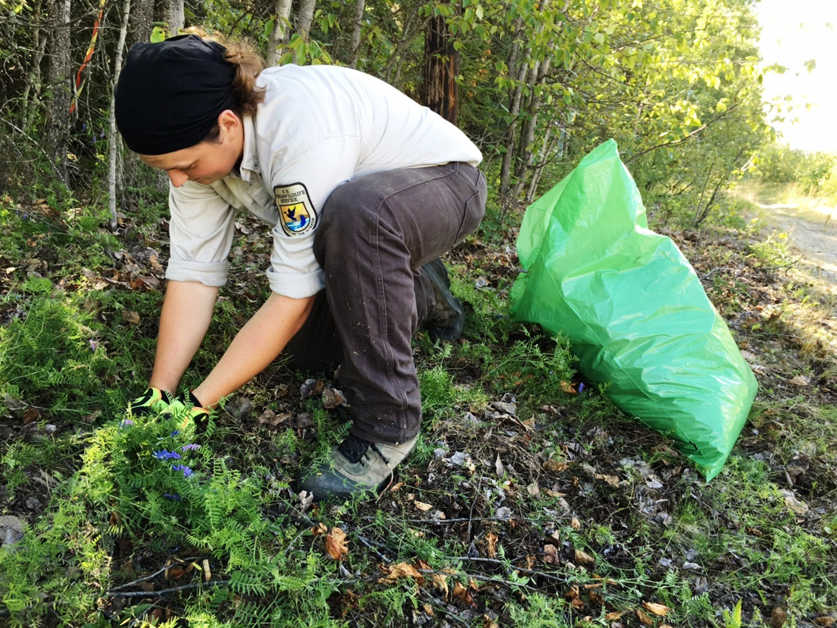Invasive species are a great concern the world over. An invasive species is one that is not native to an area, and potentially disrupts or damages native species populations. Northern pike, for example, are native in waters north of the Alaskan Range but, in southcentral Alaska, they are considered an invasive species. Introduced illegally into waters of the Kenai Peninsula by people presumably looking for more sport fishing opportunities, pike have become a problem by drastically reducing trout and salmon populations in many areas. So the Alaska Department of Fish and Game (ADF&G) has begun taking steps to deal with this species.
As a biological intern with the Kenai National Wildlife Refuge, I was assigned to be a field grunt for a week to help ADF&G eradicate pike from the Soldotna Creek watershed. Many native fish in the creek are being temporarily held captive while Rotenone, a compound derived from tropical plants in the bean family, was applied to kill pike. Rotenone is a very effective chemical that targets the cellular respiration process in gilled organisms while remaining relatively harmless to mammals and birds at the concentrations used for fish control.
Drip stations (that meter out Rotenone) were established along the mainstem of Soldotna Creek while a helicopter sprayed more inaccessible wetlands. Two- and three-person crews with backpack sprayers treated any stagnant water that could have been missed. One-pound Rotenone mixture balls were used to treat smaller tributaries. A treatment station added potassium permanganate at the mouth of Soldotna Creek to neutralize Rotenone before it entered the Kenai River so as not to affect returning salmon. Rob Massengill, ADF&G project coordinator, contacted landowners surrounding the creek beforehand and they overwhelmingly supported the project.
On Day 1 of the five-day project we were briefed on what was to be done, grabbed our personal protective equipment, prepared our packs and then headed out. Once we arrived at our location and put on our PPE, it become more than obvious that it was going to be a long day. Cooking like fish on a fire, we fought our way through the day, seconds turning into minutes, minutes to hours and eventually we hit our home stretch. In those moments, many of us hated that we signed up for this project but deep down were proud. We were taking steps in solving a serious problem.
Invasive species, whether plant, animal or fungus, can cause serious problems. These species can out-compete native species or prey upon them. Salmon, for example, play a very key role in the lives of many predators, including some humans. Beginning to deal with the pike problem allows for these species (and us!) to continue to thrive and succeed.
Meadow hawkweed is another invasive species I have the honor of helping eradicate. This hawkweed is a perennial herb native to Europe. It grows in dense fields that decrease native plant diversity and can cause issues for animals that would normally graze there. Because of impacts this weed can have on our ecosystems, it was deemed necessary to begin taking steps towards eradicating it from the Swanson River Oil Field within the Kenai Refuge. Searching through the area with our backpack sprayers, we joined two private contractors in tackling this problem, slowly beginning to destroy hawkweed on roads, pipeline corridors and well pads.
In Cooper Landing, another invasive plant had taken root by the post office and was fast on track to spread to nearby Kenai Lake and the Kenai River. White sweet clover, a species native to Eurasia, seems to have recently infested the post office grounds so I and other Refuge interns headed out there to get our hands dirty. We spent a day-and-a-half pulling all the clover, hopefully before it went to seed. It’ll need to be checked next summer to ensure it was eradicated from the area.
Last summer, herbicide treatments to elodea, an extremely invasive and injurious aquatic plant, were completed in three lakes north of Nikiski by partners in the Kenai Peninsula Cooperative Weed Management Area. Almost immediately after elodea was discovered in late 2012, steps were put into action to stop it. I’ve already participated in multiple surveys this summer that have yet to find any elodea in the treated lakes or in any other lakes on the peninsula.
I’ve learned that attitude counts in managing invasive species. There needs to be a willingness to do what you have to do to make them go away. When a species first arrives it might not cause issues but, without proactively dealing with it, it is enabled and allowed to perpetuate to a state that may be irreversible (certainly without great expense). People say the first step to solving a problem is admitting you have one. With invasives, the next step that follows soon after should involve getting your hands dirty.
Joel Stone is a biological intern at Kenai National Wildlife Refuge. He is an undergraduate student at the University of Alaska Fairbanks, majoring in Wildlife Biology. Find more information at http://www.fws.gov/refuge/kenai/ or http://www.facebook.com/kenainationalwildliferefuge.

